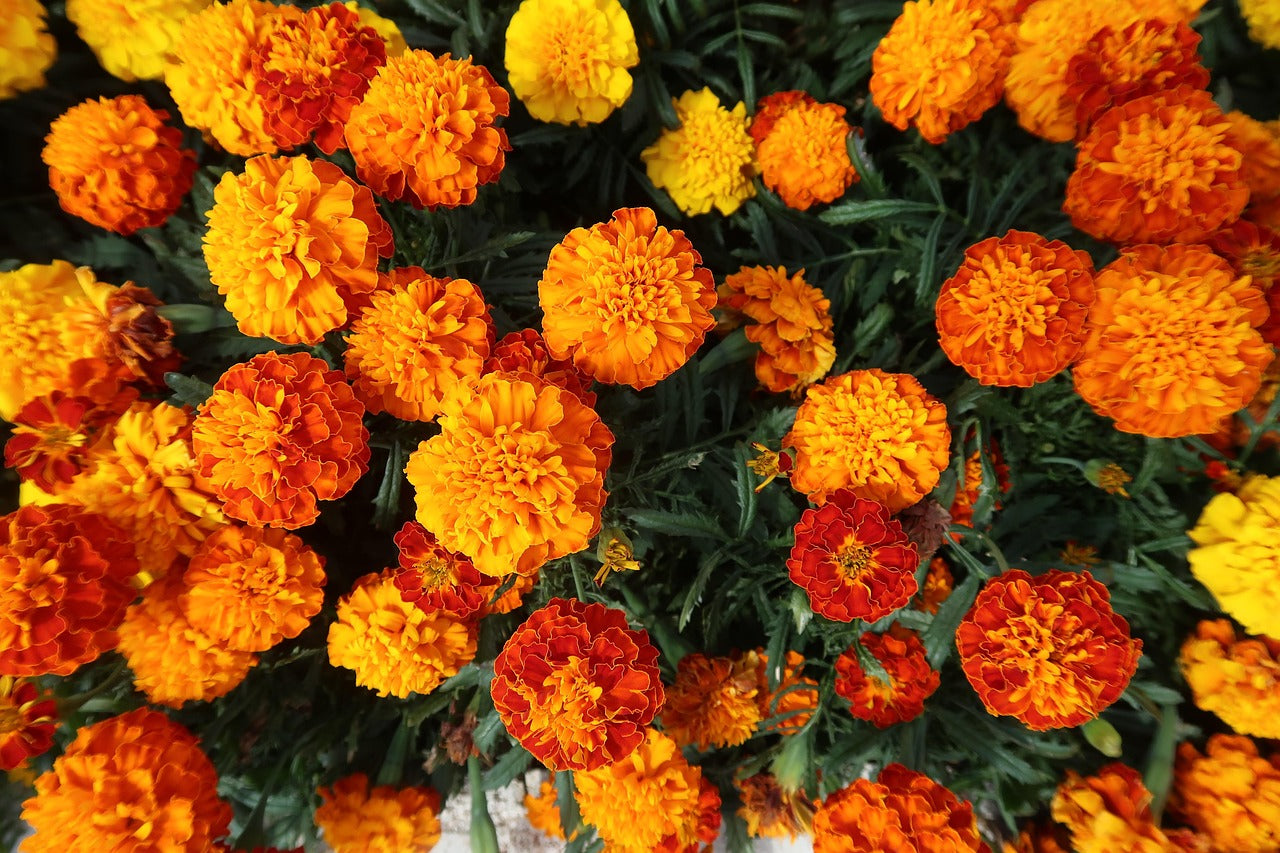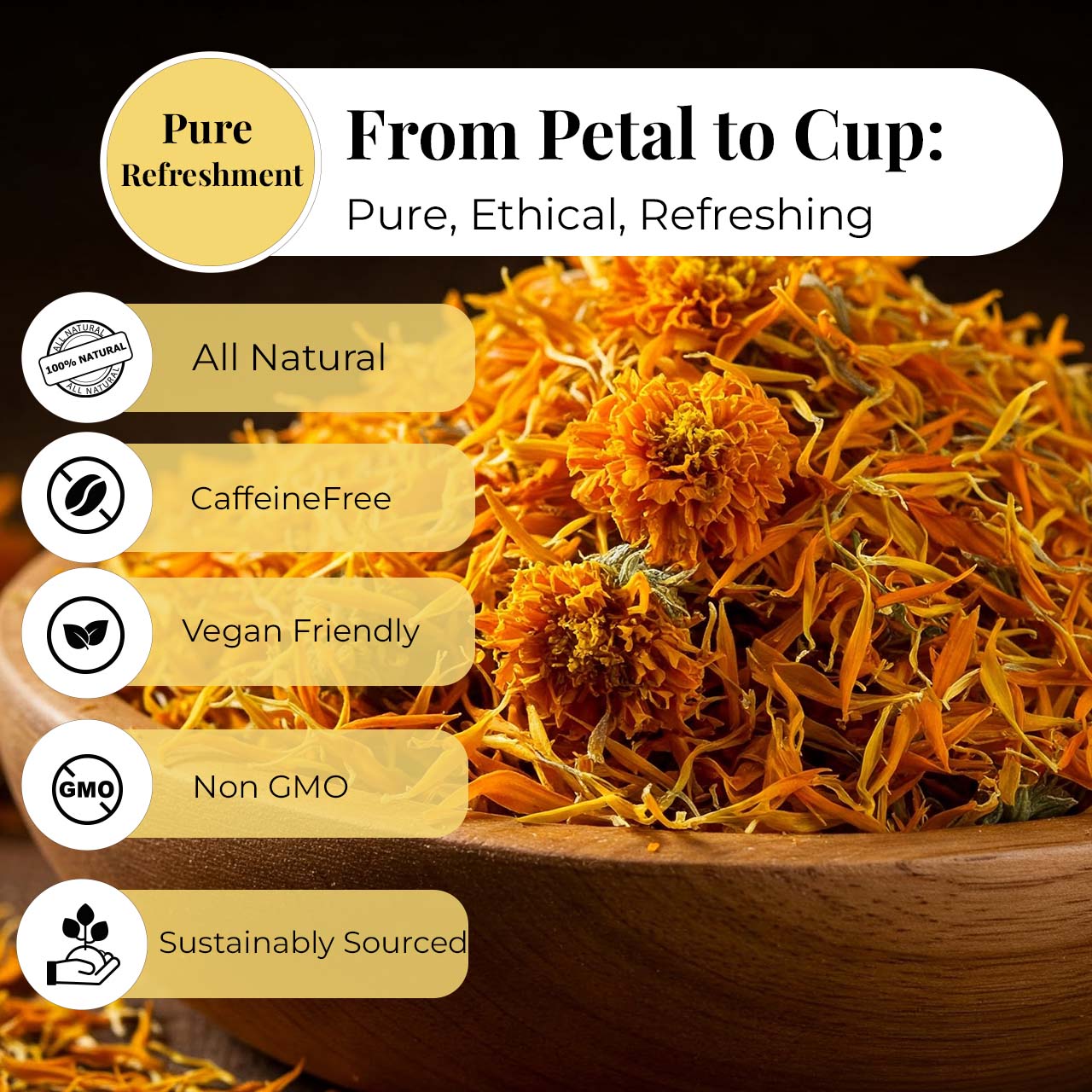Buy your weekday smoothies and get your weekend ones for free. (7 for the price of 5!)

A Quick Glance at Marigold’s Popularity
Marigold flowers are often the unsung heroes of the botanical world. You’ve probably seen them in vibrant yellow or deep orange hues lining garden paths, adorning temples, or nestled in festive decorations. But what’s more surprising is how much power is packed into these small blossoms. For centuries, marigolds have been celebrated not just for their aesthetic charm but for their multi-purpose uses in medicine, food, and culture.
Their versatility is unmatched—used in everything from traditional healing to modern skincare and even in culinary experiments. Whether it's a wedding ceremony in India or Day of the Dead altars in Mexico, marigolds hold their own among the most revered plants in the world. These golden gems are a symbol of brightness, positivity, and life itself. And the best part? They’re incredibly easy to grow and maintain, making them a favorite for both novice and expert gardeners.
So, whether you’re here out of curiosity or you’re genuinely looking to integrate marigolds into your lifestyle, you’re in for a golden experience.
Botanical Origins and Types
Marigolds belong to the Tagetes genus and are native to North and South America. Over time, they spread across the globe and became integral to many cultural landscapes. Today, there are more than 50 species, but the most common types include:
-
African Marigold (Tagetes erecta): Known for their tall stature and large, round blossoms. Often used in ceremonial and decorative purposes.

-
French Marigold (Tagetes patula): Smaller in size, but big on fragrance. These are often found in garden borders and are popular in pest-repelling plant mixes.

-
Signet Marigold (Tagetes tenuifolia): Delicate and edible, these marigolds are a chef’s favorite for garnishing salads and desserts.

Each type has its unique charm and application. African marigolds tend to be more visually dramatic, while French marigolds are often used for their strong aroma and insect-repelling properties.
What is So Special About Marigolds?
Their Striking Color Palette
Marigolds are a visual feast. Their petals range from sunshine yellow to burnt orange, and even shades of red and gold. Their bright, warm colors are not just eye candy—they serve practical purposes too. The vibrant hues attract pollinators like bees and butterflies, helping in the natural propagation of plants. And guess what? These same colors make marigolds a popular choice in photography, design, and art.
But it’s not just about looks. These flowers can withstand heat and sun like champions. While other blooms wither under harsh summer rays, marigolds hold their heads high. This makes them ideal for regions with scorching temperatures where most flowers struggle to survive.
Resilience and Easy Cultivation
One of the biggest reasons gardeners and farmers love marigolds is their fuss-free nature. They’re not picky about soil, water, or temperature. In fact, they thrive in almost any environment as long as they get a good dose of sunlight. This resilience makes them a go-to plant for beginners.
Marigolds also grow quickly, which means you’ll see blooms in just 6 to 8 weeks from planting. They're annuals, meaning they complete their life cycle in one growing season, but they reseed easily, often surprising you with new blooms the following year. Nature’s little gift that keeps on giving!
Cultural Importance Globally
Marigolds are more than just ornamental flowers—they’re deeply woven into the cultural and spiritual fabric of many societies.
-
In Mexico, marigolds are called "Flor de Muerto" or "Flower of the Dead" and are prominently featured in Day of the Dead celebrations. It’s believed their scent guides spirits to their altars.
-
In India, marigolds are central to religious festivals like Diwali and weddings. They symbolize purity and auspiciousness.
-
In Nepal, marigolds are used during the Tihar festival, often worn by dogs to honor their loyalty.
These diverse uses show how marigolds transcend continents, connecting people through ritual, remembrance, and celebration.
What is Marigold Used For?
Traditional Medicinal Applications
Marigolds have been used in traditional medicine for centuries, particularly in herbal remedies. The most commonly used variety for medicinal purposes is Calendula officinalis, often confused with Tagetes. Calendula has strong anti-inflammatory, antifungal, and antibacterial properties.
Marigold extracts are used in:
-
Wound healing ointments
-
Burn relief gels
-
Digestive teas
They’re believed to help with everything from sore throats to menstrual cramps and even skin irritations. Natural healers and modern herbalists alike respect marigold for its healing magic.
Insect Repellent and Gardening Use
Got a pest problem in your garden? Marigolds might be your new best friend. These flowers emit a distinctive scent that repels common garden pests like aphids, whiteflies, and even nematodes—microscopic worms that attack plant roots.
That’s why many gardeners plant marigolds alongside tomatoes, peppers, and beans. This method, known as companion planting, not only protects vegetables but also enriches the soil with natural nutrients released by marigold roots.
Cosmetic and Skincare Use
Marigold isn’t just a healer—it’s also a beautifier. Calendula-infused creams, oils, and lotions are common in natural skincare lines. These products aim to:
-
Soothe irritated skin
-
Fight acne and inflammation
-
Provide antioxidant protection
DIYers also make marigold-infused oils at home by soaking dried petals in carrier oils like olive or jojoba. The result? A golden elixir for your skin.
What Do Marigolds Symbolize?
Spiritual and Religious Significance
In the spiritual world, marigolds are more than just beautiful—they’re sacred. In Hindu rituals, garlands of marigold are offered to gods and goddesses. They represent devotion, purity, and the energy of the sun. Marigolds are believed to attract positive energy and ward off negativity, which is why they’re commonly seen at entrances during festivals.
In Christianity, marigolds were once called "Mary’s Gold" and were used in offerings to the Virgin Mary. That’s how the name “marigold” actually came into being.
Meaning in Different Cultures
-
In Mexico, marigolds symbolize remembrance and the eternal cycle of life and death.
-
In Western culture, they often represent grief and loss but also resurrection.
-
In Buddhist traditions, marigolds symbolize the impermanence of life and are used in funeral rituals.
These layered meanings add depth to the flower’s already rich identity, making it a meaningful gift and decoration in multiple life events.
Symbolism in Art and Literature
Artists and poets have long used marigolds to express themes of love, loss, and spiritual awakening. From Mexican folk art to contemporary paintings, marigolds often symbolize a connection to the divine or the departed.
In literature, marigolds have been metaphors for resilience, joy, and sometimes even envy. Their bold appearance makes them an unforgettable muse for creatives worldwide.
What Can You Make With Marigolds?
Infused Oils and Teas
One of the most therapeutic uses of marigolds is in the form of infusions—either as oils or teas. You’d be surprised how easy it is to turn these vibrant blooms into healing products at home. All you need are dried marigold petals, a neutral carrier oil (like olive or jojoba oil), and some patience. Steeping the petals in oil for a couple of weeks in a warm, dark place yields a golden, fragrant oil packed with anti-inflammatory and antimicrobial benefits. This oil can then be used to soothe irritated skin, reduce redness, or even help with mild burns.
Marigold tea is another common and natural remedy, particularly useful for sore throats, stomach upset, and menstrual cramps. Simply steep dried petals in hot water for 5–10 minutes. The tea has a mild, earthy flavor and a deep golden hue that looks as comforting as it tastes. Some even mix marigold tea with other herbs like chamomile or mint for added benefits and a more balanced flavor.
These infusions not only provide medicinal benefits but also offer a wonderful ritualistic way to slow down and care for your body naturally.
Natural Dyes
Ever thought of using marigolds as dye? Their strong pigments make them perfect for fabric coloring, especially if you're into DIY and sustainable fashion. Marigold petals yield a range of hues from bright yellow to burnt orange depending on the mordant (the agent that helps dye bind to fabric) and the material used.
To create marigold dye at home:
-
Collect and dry the petals.
-
Boil them in water to release their pigments.
-
Soak your fabric in a mordant solution.
-
Dip it into the marigold dye and let it sit.
Natural dyes are a great alternative to chemical-laden commercial dyes and are often used in eco-fashion, arts, and crafts projects. The beauty lies in their imperfections—each piece dyed with marigold has its unique tone and texture, making it one of a kind.
Decorative Crafts and Potpourri
Marigold flowers dry beautifully, retaining much of their color and fragrance, which makes them excellent for craft projects. Dried marigold petals can be used to create:
-
Potpourri mixes with lavender, rose petals, and essential oils
-
DIY floral candles
-
Flower garlands for home decor
-
Resin jewelry or bookmarks
You can also use pressed marigold flowers in scrapbooking, greeting cards, or framed wall art. These crafts aren’t just aesthetically pleasing; they’re also a great way to preserve the symbolic meaning and beauty of marigolds all year round.
Is Eating Marigolds Good For You?
Edibility and Safe Varieties
Yes, marigolds are edible—but not all kinds. The most commonly consumed edible marigold is Calendula officinalis, often referred to as “pot marigold.” The Tagetes species (like French or African marigolds) are generally not toxic, but they do have a more pungent, bitter flavor that can be off-putting in large amounts.
When incorporating marigolds into your meals, it’s important to:
-
Use only organically grown flowers (no pesticides)
-
Wash them thoroughly
-
Avoid parts like the green base of the flower, which can be bitter
You can sprinkle marigold petals over salads, soups, and pasta or use them to garnish desserts. The petals add not just color, but also a tangy, citrus-like flavor that’s both refreshing and unexpected.
Nutritional Content
Marigold petals, particularly those from calendula, are surprisingly nutritious. They contain:
-
Flavonoids: Plant compounds with antioxidant properties
-
Lutein and Zeaxanthin: Important for eye health
-
Vitamin C: Supports immune function
-
Beta-carotene: Converts to Vitamin A in the body
These compounds make marigolds more than just a pretty plate garnish—they actually contribute to your well-being.
Potential Health Benefits
Eating marigold petals in moderation may offer several health benefits:
-
Anti-inflammatory properties: Help with skin conditions and internal inflammation
-
Digestive aid: Marigold tea or petals can calm the digestive tract
-
Immune support: Thanks to antioxidants and vitamin C
-
Eye protection: Lutein and zeaxanthin help protect against age-related eye conditions
As with any edible flower, moderation is key. Too much of any herbal product can cause reactions, especially in people with allergies. Always start with small quantities and consult a healthcare provider if you have concerns.
What is the Best Way to Use Marigolds?
Culinary Uses
Marigolds might not be the first thing that comes to mind in the kitchen, but they’re surprisingly versatile. Chefs and food enthusiasts often use them to:
-
Garnish cakes, cupcakes, and cocktails
-
Infuse oils or vinegars
-
Mix into compound butters or herbed cheeses
-
Add flair to rice dishes or salads
In fact, calendula is often called “poor man’s saffron” because its dried petals can mimic the golden color of saffron in dishes like risotto or paella. You can also blend marigold petals with honey or lemon juice for a refreshing herbal lemonade.
The flavor of marigolds ranges from mildly citrusy to bitter-spicy depending on the species, so it's best to experiment in small batches to find what suits your palate.
Home Remedies
In folk medicine, marigold is often used to create homemade remedies. A few common applications include:
-
Marigold salve: Great for cuts, scrapes, or insect bites
-
Soothing foot soak: Infuse warm water with dried petals to relax tired feet
-
Herbal steam: Boil petals in water and inhale the steam to relieve congestion
Because of their antimicrobial properties, marigold-based balms and oils are also popular among people with acne or eczema. They’re gentle enough for most skin types and free from synthetic additives.
Ornamental and Ritualistic Use
Lastly, let’s not forget the sheer joy marigolds bring as decorative elements. Their bright blooms can instantly uplift the mood of a room, garden, or celebration. You can use them to:
-
Create garlands for weddings or religious events
-
Float petals in water bowls for visual serenity
-
Decorate home altars and entryways
In many cultures, marigolds are placed in doorways and windows as a spiritual shield to protect against negative energy. Their enduring beauty and spiritual power make them a staple in traditional practices across the globe.
Unique and Delicious Marigold Recipes
Red Rubies Jackfruit Jelly with Marigold Evaporated Creamer
This colorful Thai-inspired dessert fuses tropical flavors with floral freshness. The ruby-red water chestnuts, jackfruit slices, and crushed ice make a refreshing base, but what elevates this treat is the luxurious Marigold evaporated creamer.
Ingredients:
-
1 can Marigold Evaporated Creamer
-
1 cup water chestnuts (diced and soaked in red food coloring)
-
1 cup jackfruit strips
-
2 cups crushed ice
-
1 cup coconut milk
-
Sugar syrup (to taste)
-
Tapioca flour (for coating)
Instructions:
-
Coat colored water chestnuts in tapioca flour and boil until translucent.
-
Prepare a bowl with jackfruit strips, crushed ice, and “rubies.”
-
Mix coconut milk and sugar syrup, then top with Marigold Evaporated Creamer.
-
Serve chilled.
This dessert is not only eye-catching but also offers a delightful mix of textures and flavors.
Semperit Cookie with Marigold Sweetened Condensed Filled Milk
These melt-in-your-mouth Malaysian cookies get a creamy, sweet upgrade with Marigold sweetened condensed filled milk.
Ingredients:
-
250g butter
-
125g corn flour
-
125g all-purpose flour
-
125g icing sugar
-
1 egg yolk
-
1/2 tsp vanilla extract
-
3 tbsp Marigold Sweetened Condensed Filled Milk
Instructions:
-
Cream butter and sugar until fluffy. Add egg yolk and vanilla.
-
Mix in flour and condensed milk.
-
Pipe into flower shapes and bake at 160°C for 15 minutes.
-
Let cool before serving.
Soft, buttery, and just sweet enough—these cookies are perfect for festive occasions or a cozy evening snack.
Corn Gula Melaka Milkshake with Marigold Evaporated Creamer
This Southeast Asian-inspired milkshake combines sweet corn, palm sugar (gula melaka), and the rich creaminess of Marigold evaporated creamer for a unique beverage.
Ingredients:
-
1 cup cooked sweet corn
-
2 tbsp gula melaka (melted)
-
1/2 cup Marigold Evaporated Creamer
-
1/2 cup milk
-
Ice cubes
Instructions:
-
Blend sweet corn, gula melaka, milk, and Marigold creamer until smooth.
-
Add ice and blend again until frothy.
-
Serve immediately with a sprinkle of grated coconut (optional).
Refreshing, creamy, and naturally sweet—this milkshake is a summer favorite.
Growing and Caring for Marigold Plants
Ideal Soil and Sunlight
Growing marigolds is a satisfying experience, even for those who consider themselves “plant killers.” These flowers are some of the easiest to cultivate and thrive in a variety of conditions. That said, giving them the right start makes all the difference.
Marigolds prefer well-draining soil that’s rich in organic matter. While they’re not overly picky, a slightly acidic to neutral pH (6.0–7.0) is ideal. If you're working with heavy clay or overly sandy soil, mix in some compost to improve texture and fertility.
As for light, marigolds are sun worshippers. They need full sunlight for at least 6 hours daily. More sun equals more blooms. In partial shade, they may grow leggy and flower less frequently. So choose the brightest spot in your garden or balcony for maximum impact.
Watering and Fertilizing Tips
Despite their sun-loving nature, marigolds don’t demand much water. In fact, overwatering is one of the quickest ways to ruin a healthy plant. The key is to water deeply but infrequently. Wait until the top inch of soil is dry before the next watering session.
Young plants need regular watering to establish strong roots, but once mature, they are surprisingly drought-tolerant.
When it comes to feeding, marigolds don’t require heavy fertilization. Overfeeding can result in lush foliage with few flowers. Instead, apply a balanced, slow-release fertilizer at the time of planting. Mid-season, a dose of compost or organic liquid fertilizer can encourage more blooms.
Dealing with Pests and Diseases
Marigolds are famous for their pest-repelling abilities, but they aren't invincible. Common problems include:
-
Aphids
-
Spider mites
-
Leafhoppers
-
Powdery mildew
To combat these, use neem oil or a mild insecticidal soap. Regular pruning and deadheading (removing faded flowers) not only help reduce pests but also promote continuous blooming.
Spacing is also essential—crowded marigolds are prone to fungal issues. Make sure there’s adequate air circulation between plants.
Marigolds in Culture and Celebrations
Marigolds in Day of the Dead
One of the most iconic uses of marigolds is during Día de los Muertos (Day of the Dead) in Mexico. Known locally as “Cempasúchil,” marigolds are believed to guide the spirits of the deceased back to the world of the living with their vivid color and potent scent.
Altars (ofrendas) for the dead are adorned with marigold garlands, crosses, and petals scattered like a golden path. The flower is seen as a symbol of the fragility and beauty of life, making it the perfect tribute to lost loved ones.
During the celebration, marigolds aren’t just used decoratively—they’re deeply symbolic and emotionally significant, bridging the spiritual and earthly realms.
Indian Weddings and Festivals
Marigolds are a staple in Indian traditions. You’ll find them strung into garlands for weddings, hung on doorways during Diwali, or laid before deities during pujas (ritual prayers). The colors—mainly orange and yellow—are considered auspicious and represent prosperity, purity, and the divine energy of the sun.
In weddings, marigold petals are showered upon the bride and groom as a blessing. Temples are often decorated entirely with marigolds, and many people grow them at home for use in daily worship.
Southeast Asian Traditions
In countries like Thailand, Indonesia, and Vietnam, marigolds are also integrated into spiritual life. They are used in Buddhist rituals, particularly in temple offerings. In Bali, for example, marigolds are a part of “canang sari”—daily offerings to the gods made with flowers, food, and incense.
Their rich scent and bright appearance make them favorites for creating spiritual ambiance and enhancing the meditative experience.
Marigold in Alternative Medicine
Marigold in Ayurveda
In Ayurvedic medicine, marigold—specifically calendula—is known for its cooling properties and ability to balance the Pitta dosha. It’s used in formulations for skin ailments, eye infections, and digestive disorders. The flower is believed to have:
-
Anti-inflammatory effects
-
Antimicrobial power
-
Skin-soothing benefits
Common Ayurvedic applications include marigold ghee, herbal compresses, and infused oils. It’s even used in Ayurvedic eye washes and bath rituals to detoxify and calm the body.
Marigold in Traditional Chinese Medicine
Though less common in Traditional Chinese Medicine (TCM), marigolds are recognized for their ability to:
-
Clear heat and toxins
-
Reduce inflammation
-
Support liver health
They’re often used in herbal teas and salves, especially for skin irritations, ulcers, and minor wounds. In some regional practices, marigold is paired with herbs like chrysanthemum for its synergistic cooling effects.
Western Herbalism Practices
In Western herbalism, marigold—especially calendula—is considered a top-tier skin herb. It’s found in a wide range of tinctures, creams, and herbal supplements. Herbalists often recommend marigold for:
-
Eczema and psoriasis
-
Varicose veins
-
Wound healing
-
Lymphatic drainage
It’s also taken internally as a gentle detoxifier. Herbal teas made from calendula are thought to promote liver health and immune function, while the flower’s extracts are used in everything from lip balms to healing salves.
Crafting with Marigolds
DIY Marigold Garlands
Making marigold garlands is a fun and therapeutic project, especially during festive seasons. They’re easy to make and instantly add a pop of color to your decor.
Materials:
-
Fresh marigold flowers
-
Thick needle
-
Cotton thread or twine
Instructions:
-
Cut flower stems short.
-
Thread a needle with your twine.
-
Carefully string each flower through the center.
-
Repeat until you reach your desired length.
Hang garlands on doors, windows, or altars for a warm, festive touch. You can also dry the garlands to use as long-lasting decorative elements.
Natural Marigold Candles
Marigolds also make gorgeous, all-natural candles. You can embed dried petals into homemade wax candles for both scent and aesthetic.
Quick method:
-
Melt soy or beeswax
-
Add dried petals and essential oils (like lavender or orange)
-
Pour into molds or jars
-
Let cool and set
The result is a beautiful, rustic candle that brings calming energy and floral charm to any space.
Pressed Marigold Art Projects
Pressed flowers are an old-school art form that’s making a comeback. Pressed marigolds can be framed, used in bookmarks, or even included in resin coasters.
To press marigolds:
-
Place petals between parchment paper inside a heavy book.
-
Add more books on top for weight.
-
Wait 7–10 days until dry and flat.
Use these pressed petals in scrapbooking, journals, or handmade cards for a personal, floral touch.
Environmental Benefits of Marigolds
Pollinator Attraction
Marigolds are a pollinator’s paradise. Bees, butterflies, and hoverflies are especially drawn to their vivid colors and abundant nectar. This makes them a great choice for creating a pollinator-friendly garden, essential for maintaining biodiversity.
Adding marigolds to your flowerbeds supports local ecosystems and encourages the presence of beneficial insects that help your plants thrive.
Soil Protection and Pest Control
Marigold roots release substances that repel nematodes—microscopic pests that can destroy vegetable crops. This makes them a natural ally in maintaining healthy soil.
Additionally, their dense foliage acts as a living mulch, shading the soil and preserving moisture. This helps prevent erosion and suppress weed growth, making your garden more self-sustaining.
Companion Planting Techniques
If you’re into vegetable gardening, marigolds are a must-have. They’re ideal companions for:
-
Tomatoes
-
Peppers
-
Beans
-
Cucumbers
By planting marigolds alongside these crops, you not only reduce pest infestations but also improve overall plant health. Their strong aroma confuses pests and deters them from attacking nearby plants.

































